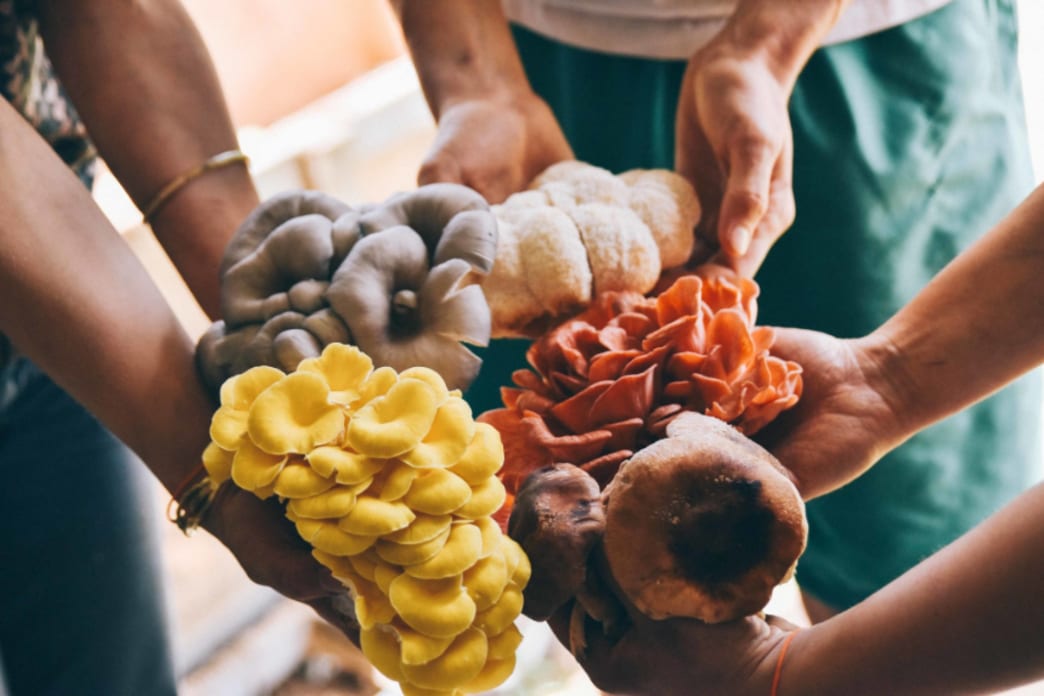Discover the benefits of an all-in-one mushroom grow bag so you can start growing mushrooms with ease
Interested in knowing the components of an all-in-one mushroom grow bag? You’ve come to the right place!
The all-in-one mushroom grow bag options we offer are 10 pounds of fully-colonized substrate, which consists mainly of organic red oak. The substrate is colonized with the mushroom species of your choice, as we currently carry a variety. The kit comes in a plastic bag with a filter patch, which can be recycled once you are finished with it.
The mushroom species we offer in our all-in-one mushroom grow bag kits
The all-in-one mushroom grow bag has been inoculated with spores of a mushroom species and allowed to incubate and colonize the substrate before it is shipped to you. We refer to these kits as “all-in-one” because they contain everything you need to start growing mushrooms. The kits come with instructions on how to use them so you are all set to start once the kit arrives. If for some reason you didn’t receive instructions, please send us an email and we will email you the instructions.
Here is a look at the species we currently offer for the all-in-one mushroom grow bag:
Blue oyster mushroom: The blue oyster mushroom is a great place to start your foray into mushroom farming because the blue oyster is an aggressive grower that can tolerate a large range of temperatures. Learn all about the blue oyster mushroom in this article on our website.
Shiitake mushroom: The shiitake is one of the most popular mushrooms in the world and with good reason. The earthy, nutty, umami flavor of the shiitake adds a delicious flavor to the many dishes it’s used in. There are a variety of reasons to eat shiitake mushrooms, which you can learn about in this article on our website.
Lion’s mane mushroom: Lion’s mane is a very unique mushroom. The fruited body is globe-shaped with often long, shaggy spines or teeth. It does not have the common cap and stem like many familiar mushrooms. Not only does this mushroom provide a desirable texture and taste, studies have also shown that lion’s mane may promote cerebral and nervous system support.
Golden oyster mushroom: If you like pretty colors, then the golden oyster mushroom is an option for you. The flavor of the golden oyster mushroom has a balanced, yet slightly nutty flavor when cooked.
King oyster mushroom: Also known as the king trumpet mushroom, this mushroom looks and tastes differently from other oysters. The king oyster grows large, thick stems with small caps, and you can eat both parts. This mushroom has a different texture than the other oyster mushrooms, so if you want a meatier mushroom this one's for you. The king oyster is in my top three mushrooms to eat due to its texture, which reminds me of tender chicken. It will absorb the flavors that it is cooked with, while providing a slight sweetness.
Pioppino mushroom: Many people have never heard of the pioppino mushroom. Also known as the black poplar mushroom or the velvet pioppino, this mushroom has an earthy and nutty flavor. In Asia this mushroom is frequently used in soups, stews, and hot pot. Once cooked the mushroom can have a slight crispiness to it. This mushroom requires lower temperatures and a high humidity so keep that in mind if you choose to grow this one at home.
Reishi mushroom: The reishi mushroom has been used for medicinal purposes for hundreds of years. This kit will yield reishis that grow like antlers and can be used to make tea or tincture. Reishi is not commonly eaten due to its texture and taste, but it goes great as a tea or tincture. Reishi can be found growing in the wild in various locations throughout the country, but this kit allows you to grow your own indoors when it is not foraging season.
Phoenix oyster mushroom: Also known as the Italian oyster or the true summer oyster, this mushroom has an aroma reminiscent of seafood. It has a mildly sweet flavor and a velvety texture. The phoenix oyster looks similar to the pearl oyster mushroom, although it tends to have smaller caps and larger stems.
Black oyster mushroom: This interesting hybrid brings in two Pleurotus ostreatus strains, although it has a look that is more along the lines of the king trumpet (Pleurotus eryngii). If you’ve grown oyster mushrooms before, this one is a must to try as well, especially if you like king trumpets.
Chestnut mushroom: Don’t confuse this mushroom for the baby bella or crimini (Agaricus bisporus)! The chestnut mushroom (Pholiota Adiposa) is commonly misidentified as the aforementioned mushrooms, although it is truly in the same family as the nameko mushroom. If you ask me, the chestnut mushroom tastes much better than the common button mushroom. Chestnut mushrooms have small, brown caps that often collect pieces of the veil after it has opened. This mushroom becomes slightly crispy after cooking it, and it adds a mild, earthy and peppery taste to dishes.
Get the entire line of all-in-one mushroom grow bags for a delicious mushroom feast at your home!

